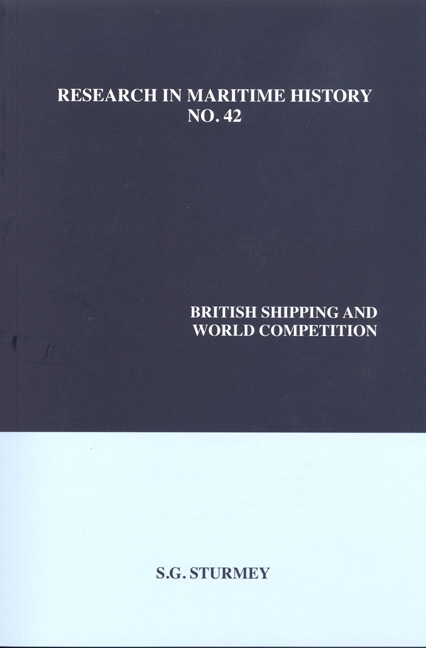Book contents
- Frontmatter
- Table of Contents
- Series Editor's Foreword
- About the Author
- Preface
- Figures and Tables
- Chapter 1 The Problem Defined
- Chapter 2 High Water: The Pre-1914 Period
- Chapter 3 War and Reconstruction
- Chapter 4 The Troubled Years: The Interwar Period
- Chapter 5 Nationalism in Shipping in the Interwar Years
- Chapter 6 The Birth of the Liberty
- Chapter 7 The Prosperous Age: The Postwar Period
- Chapter 8 Enemies of Competition in the Postwar Years
- Chapter 9 Flags of Convenience
- Chapter 10 Economics of Shipping Enterprises
- Chapter 11 Shipowning and Resource Allocation
- Chapter 12 Labour Relations and Labour Costs (by Basil Mogridge)
- Chapter 13 The Conference System
- Chapter 14 The Structure of the British Industry
- Chapter 15 The Question Answered
- Epilogue The Future
- Appendix The Contribution of British Shipping to the Balance of Payments
- Bibliography
- Index
Chapter 8 - Enemies of Competition in the Postwar Years
- Frontmatter
- Table of Contents
- Series Editor's Foreword
- About the Author
- Preface
- Figures and Tables
- Chapter 1 The Problem Defined
- Chapter 2 High Water: The Pre-1914 Period
- Chapter 3 War and Reconstruction
- Chapter 4 The Troubled Years: The Interwar Period
- Chapter 5 Nationalism in Shipping in the Interwar Years
- Chapter 6 The Birth of the Liberty
- Chapter 7 The Prosperous Age: The Postwar Period
- Chapter 8 Enemies of Competition in the Postwar Years
- Chapter 9 Flags of Convenience
- Chapter 10 Economics of Shipping Enterprises
- Chapter 11 Shipowning and Resource Allocation
- Chapter 12 Labour Relations and Labour Costs (by Basil Mogridge)
- Chapter 13 The Conference System
- Chapter 14 The Structure of the British Industry
- Chapter 15 The Question Answered
- Epilogue The Future
- Appendix The Contribution of British Shipping to the Balance of Payments
- Bibliography
- Index
Summary
State interference with the competitive process in shipping continued after the Second World War, as tables 8.1 and 8.2 show. The experiences in the postwar years differed from those in the interwar years in that whereas in the 1930s subsidies were the main form of assistance and preferences were relatively unimportant, in the postwar period preferences have become more important than subsidies, certainly in a numerical sense. This change has been brought about by a fundamental change of policy in Germany and Japan, and by the difference in the world economic situation in the postwar period as compared with the interwar years; in particular, the high levels of freights throughout most of the period have assured the viability of shipping enterprises which, in less prosperous conditions, would have needed subsidies if they were to survive.
Subsidies
The countries which have granted subsidies to national shipping enterprises are listed in table 8.1. In the period since 1945 the extent of subsidies to shipping has declined in all countries except the United States.
In France a construction differential subsidy is paid to cover the difference between the cost of building in a French yard and that of building overseas. Operating subsidies are given to a limited number of “national interest“ services, including the transatlantic mail and passenger service. The main shipping lines, which were taken under government control in 1937, have been fully nationalized since the war. To a large extent, therefore, the subsidies have been paid to enterprises in government ownership. The total amount currently paid in aid to French shipping appears to be less than the tax relief from the investment allowances of British shipowners.
In Italy after the war, European Recovery Program (Marshall Plan) funds were used to build new ships and to buy American war-built tonnage. Loans and subsidies for new construction were given in the immediate postwar years. However, as shown in chapter 6, the Italian mercantile fleet suffered heavy losses during the war and without either state assistance or insurance recoveries those losses could not have been replaced. Since 1954 con struction differential subsidies have been given. The government has retained the full control of shipping enterprises, which was instituted in the Fascist era, and for a large part of the cargo carried fixes the rates to be charged.
- Type
- Chapter
- Information
- British Shipping and World Competition , pp. 159 - 176Publisher: Liverpool University PressPrint publication year: 2009



